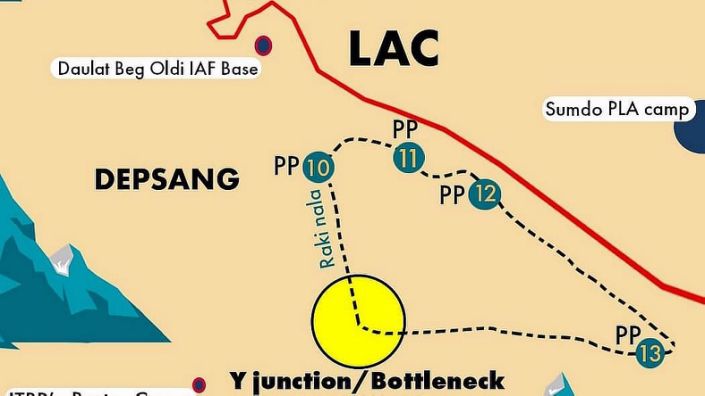-
When was the last time Indian patrol cross the point known as BOTTLENECK (7 km NORTH-East of our Burtse point) to patrol our points 10, 11, 11a, 12 and 13 along India’s Line of Patrol?
-
We have been informed by reliable sources that Indian patrols have been instructed not to confront the Chinese troops who have come to the said Bottleneck Y-junction. As a result, India’s access to the above mentioned points has been cut off.
The spokesperson responded at that time that they could not gather any information regarding this. Almost three months later, Rajnath Singh responded to a clarification sought by AK Antony in Rajya Sabha on 17 September saying, “No force in the world can stop Indian soldiers from patrolling. Our soldiers have sacrificed their lives only for this.”
S Jaishankar and his Chinese counterpart Wang Yi agreed to resolve the border standoff during a meeting in Russia though there has been no forward movement on disengagement after that.
However, the reality in Ladakh, as reported by The Quint on 26 June is far grimmer. Some of the details have been reproduced below:
In a move to avoid confrontation with the Chinese border guards, Indian troops were asked to not patrol beyond the ‘Y-junction Bottleneck,’ where China has reportedly asserted its presence. Sources share with The Quint that Indian patrols have not gone beyond the said point in Depsang area of Ladakh since March-end.
It is unlikely that the patrolling will resume any time soon, unless India chooses to tackle China head on. Satellite images show a relentless thrust of Chinese troops along the LAC in different sectors. Indian government officials are yet to decide future course of action.
How China Has Choked this Strategic ‘Bottleneck’

The Quint has been reliably informed by those dealing with the situation that PLA has marked its presence at a crucial Y-junction near the Burtse patrol camp in Ladakh. Barely 30 kms south of the strategically important Daulat Beg Oldie forward base, this Y-junction is also known as ‘bottleneck’ in Indian strategic circles because any patrol seeking to reach either Point 10 or Point 13 along the Line of Patrol, must cross this junction. See the maps above prepared by the US Army in 1950 and below (prepared by The Quint) for reference.

It is interesting to recall that the Chinese had crossed the Y-junction and stopped barely 1500 meters short of the Burtse camp in 2013. Both India and China use the route along Raki Nala, north of Y-junction, for patrolling purposes and it is not uncommon for both sides to run into each other. This happens in other sectors, along the Chinese border shared by Sikkim and Arunachal Pradesh, as well and sometimes these patrolling run-ins get heated.

In 1976, government constituted a China Study Group which revised the patrolling limits along the LAC. As can be seen from the map, patrolling points 10, 11, 11a, 12 and 13 fall slightly short of the LAC.
Incursion To Benefit Both China & Pakistan
This Y-junction 'Bottleneck' is around 17 kms west of the LAC and about 5 kms short of the Chinese claim line. As per the mutually agreed upon patrolling agreement between the two countries, both India and China have largely desisted from setting up permanent structures in the area. Border troops from both the countries patrol the area and withdraw.
A former Army Commander says that the Chinese domination of ‘Bottleneck’ aims to assert their LAC claim by blocking Indian patrols. “Since it’s called the line of actual control, whoever controls the access can claim the land and the Chinese have been at it since 1962.”
On being asked about troops not carrying out patrols beyond ‘Bottleneck’, he says that a diplomatic resolution is always better than confrontation. “If our guys want to cross the Y-junction to reach Patrolling Points 10, 11, 11a, 12 or 13, they run the risk of getting into another physical confrontation which is best avoided at this moment.”
Another Lieutenant General—a former DG of Military Operations—however, says that blocking access is almost impossible in the mountains. “Yes, nothing comes easy in the mountains but you can’t stop a man from walking. And the ‘so-called’ blocking also comes with logistical and manpower costs for the party undertaking it.”
A former DG of DIA shares that such incursions are aimed at giving China strategic depth in Ladakh. “This allows China to give advantage to Pakistan as well. This is not a new game. Siachen becomes more accessible to China through this axis and that may bolster Pakistan's position.” Pakistan’s relative silence on the matter strengthens this argument.
Need for ‘One Border One Force’ Along the LAC?
After the Kargil Review Committee's report was tabled, a committee of ministers had proposed 'One Border One Force'. Army has also been asking to be given the charge of the borders. Along the Line of Control between India and Pakistan, the BSF comes under the operational command of Army. This is not the case with ITBP along the LAC.
"This creates not only confusion and intelligence sharing delays but also an inter-ministry chain-of-command issues," shares the former Army Command.
































